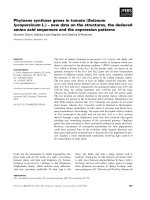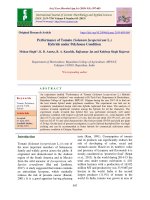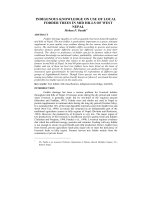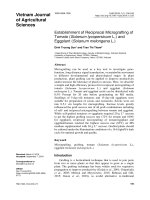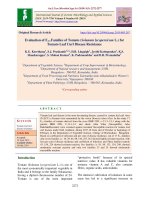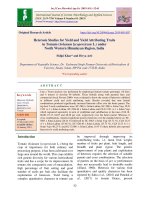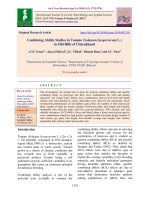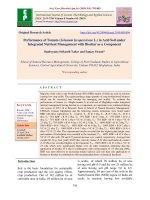Combining ability studies in tomato (Solanum lycopersicum L.) in mid hills of Uttarakhand
Bạn đang xem bản rút gọn của tài liệu. Xem và tải ngay bản đầy đủ của tài liệu tại đây (223.82 KB, 6 trang )
Int.J.Curr.Microbiol.App.Sci (2019) 8(2): 1725-1730
International Journal of Current Microbiology and Applied Sciences
ISSN: 2319-7706 Volume 8 Number 02 (2019)
Journal homepage:
Original Research Article
/>
Combining Ability Studies in Tomato (Solanum lycopersicum L.)
in Mid Hills of Uttarakhand
A.M. Veena1*, Ajaya Paliwal2, J.C. Thilak1, Himani Rana1 and S.C. Pant1
1
Department of Vegetable Science, 2Department of Crop Improvement, College of
Horticulture, VCSG UUHF, Bharsar
*Corresponding author
ABSTRACT
Keywords
General combining
ability, Specific
combining ability,
Non-additive, Half
diallel fashion
Article Info
Accepted:
15 January 2019
Available Online:
10 February 2019
The investigation was carried out to study the general combining ability and specific
combining ability in genotypes and their cross combinations for yield and quality
characters. Six tomato lines, fifteen cross combinations derived from 6×6 half diallel
fashion with Arka Rakshak as check cultivar/line were taken for the experiment. Study
revealed the predominance of non-additive gene effects for number of fruit clusters per
plant, number of fruits per cluster, number of fruits per plant, fruit length, fruit breadth,
marketable fruit yield per plant, shelf life, pericarp thickness, TSS, ascorbic acid and
whitefly infestation. AVTO-9001× Sioux and Solan Lalima × Sioux were the best specific
cross combinations which has high positive significant effects for plant height, number of
fruit clusters per plant, fruit length, fruit breadth, average fruit weight, fruit volume,
marketable fruit yield per plant and ascorbic acid.
Introduction
Tomato (Solanum lycopersicum L.) (2n = 2x
= 24) probably originated in Peru-Ecuador,
region (Rick,1990) is a herbaceous, typical
day neutral plant of warm season. Tomato
grown in a variety of climatic conditions and
has versatile uses as fresh vegetable or
processed product. Tomato being a self
pollinated crop has sufficient variability in its
germplasm that raises an enormous potential
for heterosis breeding.
Combining ability analysis is one of the
powerful tools available to estimate the
combining ability effects and aids in selecting
the desirable parents and crosses for the
exploitation of heterosis and is studied as,
general combining ability (GCA) and specific
combining ability (SCA) as defined by
Sprague and Tatum (1942). They stated that
GCA effects were due to additive type of
gene action that enables the breeders to
exploit the existing variability in the breeding
materials and identify individual genotypes
having desirable attributes while, specific
combining ability (SCA) effects are due to
non-additive (dominant or epistatic) gene
action that determines heterotic patterns
among populations or inbred lines and
1725
Int.J.Curr.Microbiol.App.Sci (2019) 8(2): 1725-1730
identify promising single crosses and to
assign inbred lines into heterotic groups.
Diallel cross analysis proposed by Griffing
(1956) is the appropriate and specific
approach for the identification and selection
of superior genetic material and the
measurement of GCA and SCA effects helps
in deciding the next phase of breeding
programme. Therefore, the present research
was undertaken with the objective to study the
GCA and SCA in genotypes and their cross
combinations for yield and quality characters.
Materials and Methods
Six diverse tomato cultivars/lines viz, AVTO9001, LC-9, Solan Lalima, Sioux, Arka
Meghali and LC-4 crossed in a 6×6 half
diallel fashion to obtain fifteen cross
combinations. The seedlings of parents, raised
in March-2016, were transplanted to attempt
crossing and generate F1’s. The fifteen F1’s
along with their parents and one check
cultivar F1 hybrid Arka Rakshak were planted
in December-2016 for their evaluation. The
experiment was laid out in Randomized
Complete Block Design (RCBD) with three
replications. There were 6 plants of each entry
in each replication in a plot of 1.2 x 1.35 m2
with a spacing of 60 cm x 45 cm. The
combining ability analysis for parental
genotypes and their crosses were carried out
following Method 2 and Model 1 of Griffing
(1956).
Results and Discussion
The GCA and SCA effects for parents and
crosses over the various traits of this
experimental study have been described
character-wise in Table 1 and 2, under the
following heads:
Plant height (cm)
Sioux (10.75), LC-4 (8.85) and Solan Lalima
(2.03) were identified as good general
combiners while, nine cross combinations
were well performing combiners with
significant positive SCA estimates involving
good × poor, average × good, poor × good
and good ×good, as general combiners. As
good cross combinations are coming
irrespective of general combining ability
values of parents therefore, hybridization
experiments may provide sufficient weightage
to poor combiners while selecting parents for
improvement of the trait. These findings are
in line with the results of Kumar et al., (2013)
for GCA effects and with Gautam et al.,
(2016)) for SCA studies.
Number of fruit clusters per plant
All the parents were average general
combiners for number of fruit clusters per
plant and SCA studies reveal that six specific
cross combinations viz, LC-9 × Solan Lalima
(1.49), Sioux × Arka Meghali (1.29), AVTO9001 × LC-4 (1.25), Arka Meghali × LC-4
(1.24), Solan Lalima × Sioux (1.15) and Solan
Lalima × Arka Meghali (1.15) to be good
specific combiners. All these superior crosses
involved average x average general
combiners. Similar trend was noticed by
Shankar et al., (2013) for SCA effects.
Number of fruits per cluster
All the parents were average general
combiners due to their non-significant GCA
effects but despite of that three cross
combinations, Solan Lalima × LC-4(1.94),
Sioux × Arka Meghali (1.75) and AVTO9001× Sioux (1.39) were good specific
combiners for this trait due to their significant
positive SCA effects.
These results for SCA find support from
Kumar and Gowda (2016), Sharma and
Sharma (2010) and for GCA with the findings
of Kumar et al., (2013) and Kumar and
Gowda (2016).
1726
Int.J.Curr.Microbiol.App.Sci (2019) 8(2): 1725-1730
Number of fruits per plant
Only one parent was poor general combiner
i.e., LC-4(-3.68) due to its significant
negative GCA effects, remaining all the five
parents were the average general combiners
for number of fruits per plant. Among fifteen
cross combinations, six cross combinations
were good specific cross combinations as
reflected by their significant positive SCA
effects involving average × average and
average × poor as general combiners. These
studies for GCA are in accordance with the
findings of Kumar et al., (2013), Gautam et
al., (2016) and for SCA with Gautam et al.,
(2016) and Kumar and Gowda (2016).
Fruit length (mm)
For fruit length two parents, LC-9 (0.23) and
AVTO-9001 (0.18) were good general
combiners with their significant positive GCA
effects. Three parents (Sioux, 0.04, Solan
Lalima -0.16, Arka Meghali -0.07) were
average general combiners and only one
parent was poor general combiner i.e., LC-4(0.22). Out of fifteen cross combinations, three
cross combinations viz, LC-9 × Arka Meghali
(0.64), AVTO-9001 × Sioux (0.45) and Solan
Lalima × Sioux (0.42) were good specific
combinations and these superior cross
combinations involved good × average and
average × average general combiners. A good
general combiner upon crossing with good or
average combiner is most likely to provide a
potential heterotic combination. These results
are similar to the findings of Pandey et al.,
(2006) and Sharma and Sharma (2010).
Fruit breadth (mm)
Among all the parents, five parents viz, Sioux
(0.15), AVTO-9001(0.15), LC-9 (0.03), Solan
Lalima (-0.14) and Arka Meghali (-0.02) were
average general combiners while remaining
one parent was poor general combiner due to
its negative significant GCA effects i.e., LC-4
(-0.18). Out of fifteen cross combinations
only three cross combinations were good
specific combiners and all these three cross
combinations involved average × average as
general combiners so there are at most
possibility that average general combiners can
give raise to good specific combiners. With
respect to GCA and SCA effects, similar
results were obtained by Pandey et al., (2006)
and Sharma and Sharma (2010).
Average fruit weight (g)
The good GCA for average fruit weight was
found in only two parents viz, Sioux (2.80)
and AVTO-9001 (1.51).
Six
cross
combinations out of fifteen found to be good
specific combiners for this trait involving
good × good, poor × good, good × average,
average × average, average × poor and
average × good general combiners sometimes
the involvement of poor as well as average
general combiners proves to be best for
getting the significant results apart from good
general combiners involvement. The results
for GCA and SCA are in accordance with the
findings of Sharma and Sharma (2010),
Kumar et al., (2013) and Agarwal et al.,
(2014).
Fruit volume (mL)
The estimates of GCA effects for fruit volume
revealed three parents namely, AVTO9001(9.38), Sioux (7.92) and Arka Meghali
(0.88) to be good general combiners due to
their positive significant GCA effects while,
remaining three parents were poor general
combiner. Seven cross combinations proved
to be good specific cross combinations for
fruit volume because of their positive
significant SCA effects involving poor ×
good, good × good, good × good as general
combiners.
1727
Int.J.Curr.Microbiol.App.Sci (2019) 8(2): 1725-1730
Table.1Estimates of general combining ability effect of parents for different parameters
Parents
Plant
Height
No. of Fruit
Clusters / plant
AVTO-9001
LC-9
Solan Lalima
Sioux
Arka Meghali
LC-4
Se (gi)
SE (gi-gj)
CD at 5%
-0.69
-2.44**
2.03**
10.75**
-18.49**
8.85**
0.287
0.044
0.727
0.07
-0.01
0.11
-0.01
-0.10
-0.05
0.156
0.241
0.394
No.
Fruits/
Cluster
0.44
-0.29
-0.23
0.21
0.26
-0.38
0.224
0.346
0.568
No.
Fruits/
Plant
2.68
-0.62
0.42
0.83
0.37
-3.68*
1.339
2.076
3.394
Fruit
Length
Fruit
Breadth
0.18*
0.23*
-0.16
0.04
-0.07
-0.22*
0.068
0.105
0.171
0.15
0.03
-0.14
0.15
-0.02
-0.18*
0.064
0.197
0.161
Average
fruit
weight
1.51*
0.45
-1.95*
2.80**
0.08
-2.88**
0.422
0.207
1.069
Fruit
Volume
9.38**
-3.30**
-5.29**
7.92**
0.88**
-9.59**
0.115
0.179
0.292
Marketable
fruit yield /
plant
0.14
-0.02
-0.08
0.26*
0.01
-0.30*
0.081
0.126
0.206
Harvest
Duration
Shelf
life
Pericarp
thickness
TSS
Ascorbic
Acid
Whitefly
0.24
0.61
-0.14
-0.06
-0.10
-0.56
1.070
1.182
2.711
-0.17
1.17
-0.26
0.76**
-1.05**
-0.45**
0.154
0.239
0.390
0.04
0.04
0.00
0.00
-0.07**
-0.01
0.017
0.052
0.043
-0.12
0.27
-0.13
0.16
-0.24
0.05
0.122
0.189
0.309
-0.29
-0.88
0.64
1.60
-0.28
-0.79
0.475
0.738
1.205
-0.74
0.22
1.78*
-1.79*
-0.50
1.03
0.534
0.783
1.353
*, ** significant at 5% and 1% level, respectively
Table.2 Estimates of specific combining ability effect of cross combinations for different parameters
Cross
Combinations
AVTO-9001 × LC-9
AVTO-9001 × Solan Lalima
AVTO-9001 × Sioux
AVTO-9001 × Arka Meghali
AVTO-9001 × LC-4
LC-9 × Solan Lalima
LC-9 × Sioux
LC-9 × Arka Meghali
LC-9 × LC-4
Solan Lalima× Sioux
Solan Lalima × Arka
Meghali
Solan Lalima × LC-4
Sioux × Arka Meghali
Sioux × LC-4
Arka Meghali × LC-4
Se (sij)
SE (sij-sjk
CD at 5%
Plant
Height
No
Fruits /
Clusters
-1.68**
0.53
1.39**
-0.51
0.82
-0.17
1.12
0.39
-1.6**
-0.25
-0.71
No
Fruits/
Plant
-12.65**
5.28
7.26
0.94
13.44**
8.11*
9.86*
-1.44
-11.7**
6.56
2.45
Fruit
Length
Fruit
Breadth
-1.58**
-20.41**
-4.43**
0.22*
20.6**
2.25**
16.8**
-11.91**
-16.74**
12.59**
19.23**
No of Fruit
Clusters
/plant
-0.43
0.5
-0.16
0.61
1.25**
1.49**
0.53
-0.28
-0.08
1.15*
1.15*
-0.08
-0.03
0.19
0.41*
0.02
0.07
0.41*
-0.03
-0.19
0.41*
-0.25
Average
fruit
weight
9.84**
-4.86**
10.72**
-0.55**
-9.76**
-8.52**
1.47**
7.77**
8.68**
9.99**
-7.21**
-0.24
-0.46*
0.45*
0.29
-0.23
0.14
-0.25
0.64**
-0.26
0.42*
-0.58**
6.09**
29.00**
10.02**
-13.58**
0.079
0.012
0.162
0.22
1.29**
-1.11*
1.24**
0.428
0.638
0.878
1.94**
1.75**
-0.57
-0.41
0.614
0.918
1.261
16.96**
25.26**
-10.9**
8.69*
3.678
5.489
7.553
-0.31
0.03
-0.87**
-0.04
0.186
0.277
0.382
-0.55**
0.07
-0.44*
-0.43*
0.175
0.260
0.359
-13.85**
-11.03**
-8.8**
-13.73**
0.037
0.055
0.075
*, ** significant at 5% and 1% level, respectively
1728
Fruit
Volume
Harvest
Duration
Shelf life
Pericarp
thickness
TSS
Ascorbic
acid
Whitefly
-1.11**
-7.9**
19.72**
13.08**
13.55**
-12.99**
21.93**
2.05**
-13.07**
18.7**
-16.13**
Marketable
fruit yield/
plant
-0.23
0.06
1.11**
0.34
0.42
0.09
0.65
0.27
-0.08
0.91**
-0.28
-1.32
2.60*
1.43
1.18
0.64
2.60*
2.18*
1.30
1.80
1.85
0.80
-0.91*
-0.62
0.51
-0.09
0.34
0.71
1.48**
-0.11
-2.03**
0.38
0.30
-0.10
0.01
0.01
0.05
-0.13**
0.10
0.02
0.02
-0.08
0.08
0.04
-1.23**
1.52**
-0.44
0.35
-0.13
1.95**
0.92
-0.09
-0.52
0.39
-0.43
-0.92
2.68
3.85**
1.66
1.22
3.11**
1.93
-0.56
-0.93
3.42**
-2.33
3.22*
2.57
-0.04
-5.42**
1.63
3.13*
-1.34
-3.43**
2.84
-1.76
-4.40**
-17.76**
5.43**
-21.63**
-8.26**
0.032
0.047
0.065
0.17
0.66*
-0.91**
-0.11
0.223
0.333
0.458
1.55
2.47*
-0.20
1.89
1.048
1.564
2.152
-1.24**
1.06*
-0.99
-1.34**
0.423
0.632
0.869
0.08
-0.01
-0.04
-0.09
0.046
0.069
0.095
0.11
0.03
-0.21
-0.01
0.336
0.501
0.690
-0.52
1.76
-2.38
-2.03
1.308
1.952
2.685
4.86**
2.23
4.36**
3.05*
1.388
2.072
2.850
Int.J.Curr.Microbiol.App.Sci (2019) 8(2): 1725-1730
Marketable fruit yield per plant (Kg)
This is the important trait in farmer point of
view and GCA studies found only one parent,
Sioux (0.26) to be the good general combiner.
Good specific cross combinations for this trait
were AVTO-9001 × Sioux (1.11), Solan
Lalima × Sioux (0.91) and Sioux × Arka
Meghali (0.66) because of their positive
significant SCA effect, involving average ×
good and good × average as general
combiners. Similar results were observed by
Kumar et al., (2013), Shankar et al., (2013)
and Agarwal et al., (2014) for GCA and SCA.
Harvest duration (days)
All the parents were average general
combiners while, SCA studies figured out
four cross combinations viz, LC-9 × Solan
Lalima (2.60), AVTO-9001 × Solan Lalima
(2.60), Sioux × Arka Meghali (2.47) and LC9 × Sioux (2.18) to be good specific
combiners despite of all general combiners
with average GCA effects. Significance is the
indication of this trait in desirable direction
with high heterotic response. A similar result
for SCA was reported by Sharma and Sharma
(2010) and Gautam et al., (2016) for GCA
effects.
general combiners. SCA studies designated
only AVTO-9001 × LC-4 (-0.13) to be poor
cross combination for pericarp thickness
while rest all the cross combinations were
average specific combiner. These findings are
in close relation with the findings of Aisyah et
al., (2016) for GCA and with Shankar et al.,
(2013), Gautam et al., (2016) and Aisyah et
al., (2016) for SCA.
Total soluble solids (0B)
For TSS all the parents were average general
combiners and only two cross combinations
were good specific combiners i.e., LC-9 ×
Solan Lalima (1.95) and AVTO-9001 × Solan
Lalima (1.52) due to their positive significant
SCA effects while, one cross was poor
specific combiner AVTO-9001 × LC-9(1.23). Remaining all the crosses were average
specific combiners due to their nonsignificant SCA effects. Similar findings was
obtained Kumar et al., (2013) for SCA studies
and for GCA studies with Shankar et al.,
(2013) and Agarwal et al., (2014).
Ascorbic acid (mg/100g)
Shelf life is the factor impacting quality and
among the parents Sioux (0.76) was the only
good general combiner and LC-9 × Sioux
(1.48) and Sioux × Arka Meghali (1.06) were
good specific cross combinations involving
average × good and good × poor respectively.
These findings were also observed by Kumar
and Gowda (2016).
All the parents were average general
combiners for ascorbic acid. Three cross
combinations were good specific combiners
i.e., AVTO-9001× Sioux (3.85), Solan Lalima
× Sioux (3.42), LC-9 × Solan Lalima (3.11)
because of their positive significant SCA
effects while remaining all the cross
combinations
were
average
specific
combiners due to their non-significant SCA
effects. The studies for SCA get the support
of literature from Kumar et al., (2013) and for
GCA with Shankar et al., (2013) and Gautam
et al., (2016).s
Pericarp thickness (mm)
Whitefly infestation (%)
Arka Meghali (-0.07) was the only poor
general combiner for pericarp thickness and
remaining all the five parents were average
Among the cross combinations three cross
combinations, AVTO-9001 × Arka Meghali (5.42), Solan Lalima × Arka Meghali (-4.40)
Shelf life (days)
1729
Int.J.Curr.Microbiol.App.Sci (2019) 8(2): 1725-1730
and LC-9 × Arka Meghali (-3.43) were good
specific cross combiners which involved
average × average, poor × average and average
× average as general combiners despite of only
Sioux (-1.79) being good combiner was unable
to express in any of the F1’s.
In conclusion, Sioux was the best general
combiner with high significant positive GCA
effects for most of the traits and inspite of
parents being average general combiners for
most of the traits Solan Lalima x Sioux emerged
out as best specific combiner with high
significant positive SCA effects for Plant height
(cm), fruit length (mm), fruit breadth (mm),
fruit volume (mL), average fruit weight (g),
number of fruit clusters per plant, marketable
fruit yield (Kg) and ascorbic acid (mg/100g).
References
Agarwal, A., Arya, D.N., Ranjan, R., and
Ahmed, Z. 2014.Heterosis,combining
ability and gene action for yield and
quality traits in tomato (Solanum
lycopersicum L.). Helix. 2: 511- 515.
Aisyah, S.I., Wahyuni, S., Syukur, M., and
Witono, J.R. 2016.The estimation of
combining ability and heterosis effect
for yield and yield components in
tomato (Solanum lycopersicum Mill.) at
lowland. Ekin Journal. 2(1):23-29.
Gautam, N., Kumar, M., Kumar, S., Vikram,
A., Dogra, R. K. and Bharat, N.
2016.Combining ability analysis and
gene action for yield and its contributing
traits in tomato (Solanum lycopersicum
L.) under North Western Himalayan
region. Ecology Environment &
Conservation. 22 (1): 345-349.
Griffing, B., 1956. Concepts of general and
specific combining ability in relation to
diallel crossing systems. Australian
Journal of Biology Sciences. 9: 463493.
Kumar, S., and Gowda, P.H.R. 2016.
Estimation of heterosis and combining
ability in tomato for fruit shelf life and
yield component traits using line x tester
method. International Journal of
Agronomy and Agricultural Research.
9(3):10-19.
Kumar, R., Srivastava, K., Singh, N.P.,
Vasistha, N. K., Singh, R. K., and
Singh, M. K. 2013. Combining Ability
Analysis for Yield and Quality Traits in
Tomato (Solanum lycopersicum L.).
Journal of Agricultural Science. 5(2):
213-218.
Pandey, S.K., Dixit, J., Pathak, V.N., and Singh,
P. K. 2006. Line x tester analysis for
yield and quality characters in tomato
(Solanum
lycopersicum
Mill.).
Vegetable Science. 33(1): 13-17.
Rick, C.M., and Holle, M. 1990. Andean
Lycopersicon
esculentum
var.
cerasiforme: genetic variation and its
evolutionary significance. Journal of
Economic Botany. 43(3): 69-78.
Shankar, A., Reddy, R.V.S.K, Sujatha, M., and
Pratap, M. 2013. Combining ability and
gene action studies for yield and yield
contributing traits in tomato (Solanum
lycopersicum L.). Helix. 6: 431-43.
Sharma, D., and Sharma, H.R. 2010.
Combining ability analysis for yield and
other horticultural traits in tomato.
Indian Journal of Horticulture. 67(3):
402-405.
Sprague, G.F., and Tatum, L.A. 1942. General
vs. specific combining ability in single
crosses of corn. Journal of the American
Society of Agronomy. 34: 923-932.
How to cite this article:
Veena, A.M., Ajaya Paliwal, J.C. Thilak, Himani Rana and Pant, S.C. 2019. Combining Ability
Studies in Tomato (Solanum lycopersicum L.) in Mid Hills of Uttarakhand.
Int.J.Curr.Microbiol.App.Sci. 8(02): 1725-1730. doi: />
1730
